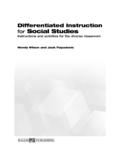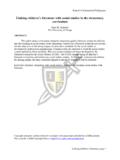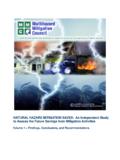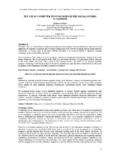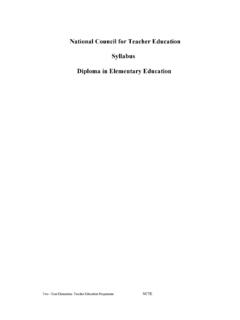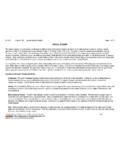Transcription of Overview of the Social Studies GED® Test
1 29 Overview of the Social Studies GED Test The GED Social Studies Test measures a candidate s skill in understanding and interpreting key history, geography, economics, and civics concepts and principles and applying them to visual and written academic and workplace contexts. The test consists of 50 multiple choice questions. Candidates have 70 minutes to complete the test. The GED Social Studies Test includes questions in the following areas: History: 40% ( history 25%, World History 15%) Geography: 15% Civics and Government: 25% Economics: 20% The questions are based on one of the following three types of source material: Prose (40%): narratives, high school textbooks, editorials, speeches, newspapers, news magazines, historical documents Visual Text (40%): maps, graphs, charts, diagrams, political cartoons, photographs, works of art Written and Visual Text (20%): a combination of any 2 of the above Prose-based questions constitute 40% of the test, and visual text or visual/written questions represent 60 %.
2 Prose sources are no longer than 200 words, and text for a single question is 50 60 words. The types of questions include: Comprehension: 20% Application: 20% Analysis: 40% Evaluation: 20% 30 The GED Social Studies Test Content Items on the Social Studies GED Test are drawn from major concepts within the national standards in history: History (25%) Native Peoples, Colonization, Settlement, Revolution, and the New Nation Western Expansion, Civil War Era, Reconstruction, and the Industrial Revolution Emergence of Modern America, Great Depression, World War II, Postwar , Contemporary United States World History (15%) Beginning and Early Civilizations Classical Traditions, Major Empires, World Religions Growing Trade, Hemispheric Interactions, Age of Revolutions (1750 1914) World Wars, Advances in Science and Technology, the Cold War, Global Culture Civics and Government (25%) Civic Life, Politics, and Government Foundations of the American Political System American Government Relationship of the to Other Nations Role of Citizens in American Democracy Geography (15%)
3 World in Spatial Terms Places, Regions, and Physical Systems Human Systems, Environment, and Society Uses of Geography Economics (20%) Economic Reasoning and Choice Comparison of Economic Systems, Business in a Free Enterprise System, Production, Consumers Financial Institutions Government s Role in the Economy, Labor and the Economy Global Markets and Foreign Trade 31 The GED Social Studies Test Context Approximately 60% of the GED Social Studies Test questions relate to concepts and issues taken from a global or international perspective, and the other 40% address questions related to national issues. Test questions are based on the following types of source material: Excerpts from narratives, high school textbooks, editorials, speeches, newspapers, news magazines, and historical documents Maps, graphs, charts, diagrams, political cartoons, and works of art Each form of the GED Social Studies Test includes an excerpt from at least one of the following fundamental historical United States documents: Declaration of Independence United States Constitution Bill of Rights Landmark Supreme Court Cases Each form includes one practical document, a source of information used by most adults in their roles as citizens, consumers, and workers, such as: Consumer information Voters guides Atlases Tax forms Budget graphs Political speeches Almanacs Statistical abstracts NOTE.
4 Students do not need to memorize Social Studies facts to pass the test. However, having general knowledge about the above Social Studies content is very important for a student s success. Developing related vocabulary is another piece of the necessary foundation for GED success. Having basic Social Studies knowledge, coupled with strong reading skills and a developed vocabulary will help your students to become well-prepared candidates for the GED Test. 32 Types of Questions on the GED Social Studies Test Critical Thinking Skills The GED Social Studies Test requires that candidates use higher-level thinking skills. However, students do need basic background in the content areas so that the contexts for the questions are familiar. Comprehension Comprehension questions (20 percent) measure the candidate s understanding of the meaning and intent of text and/or visual material.
5 Application Application questions (20 percent) measure the candidate s ability to use information and ideas in a situation different from that provided by the question stimulus. Analysis Analysis questions (40 percent) measure the candidate s ability to break down information and to explore the candidate s understanding of the relationship between component ideas. Evaluation Evaluation questions (20 percent) measure the candidate s ability to use provided criteria to make judgments about the validity or accuracy of information. For specific examples of each type of question refer to the Social Studies Locator Test and Answer Key at the end of this section. For more information about critical thinking skills see the Critical Thinking section of this booklet. 33 GED Social Studies Test Curriculum The student will demonstrate and apply reading comprehension and critical thinking skills using Social Studies text and graphic selections.
6 1. The student will demonstrate a basic understanding and knowledge of key American documents and related vocabulary including: The Declaration of Independence United States Constitution Bill of Rights Landmark Supreme Court cases 2. The student will demonstrate a basic understanding and knowledge of major American historical events and related vocabulary including: Colonization, the American Revolution, and the building of a new nation Western Expansion, Civil War, Reconstruction, and the Industrial Revolution Great Depression, World War I and II, Postwar United States, Civil Rights, and Contemporary America 3. The student will demonstrate a basic understanding and general knowledge of American civics, government and related vocabulary including: American Government Structure Foundations of the American Political System Relationship of the United States to other countries Role of Citizens in an American Democracy 4.
7 The student will demonstrate a basic understanding and knowledge of major World History events and related vocabulary including: Beginning and Early Civilizations Major Empires and World Religions Growing Trade, Global Interactions, and the Age of Revolutions (1750 1914) 5. The student will demonstrate a basic knowledge and understanding of geography and related vocabulary including: World in Spatial terms (continents, latitude, longitude, compass rose, etc.) Places, Regions and Political Systems Human Systems, Environment and Society Uses of Geography 34 6. The student will demonstrate a basic understanding and knowledge of Economics and related vocabulary including: Economic Reasoning and Choice Comparison of Economic Systems Business in a Free Enterprise System, Supply and Demand Financial Institutions Government s Role in the Economy and Labor Global Markets and Foreign Trade 7.
8 The student will apply comprehension skills to Social Studies passages and graphics. Comprehension Skills include: Restate Information Summarize ideas Identify implications Make inferences 8. The student will apply application skills to Social Studies passages, political cartoons, and graphics. Application skills include: Use information in a new context or situation Identify an illustration of a generalization , principle or strategy 9. The student will apply analysis skills to Social Studies passages and graphics. Analysis skills include: Distinguish facts from opinions Distinguish conclusions from supporting details Recognize information that is meant to persuade Recognize unstated assumptions Recognize fallacies in arguments or conclusions Recognize the point of view of a writer in a historical account Compare and contrast points of view Make inferences or predictions 10.
9 The student will apply evaluation skills to Social Studies passages and graphics. Evaluation skills include: Assess whether information is appropriate to substantiate conclusions or generalizations Assess the accuracy of facts presented in a text or graphic Compare and contrast different accounts of the same event Recognize the roles that values, beliefs, and personal convictions play in decision making 35 TEACHING RECOMMENDATIONS FOR Social Studies GEOGRAPHY Have maps and globes in your classroom. Using these maps and globes: Have students list the continents and countries in the world or the states and regions in the U. S. Make games from the lists. Match countries to continents, states to regions. This often works well with small group teams, so no individual is put on the spot. Have students find pictures and information about regions, countries, or continents at or Match states and capitals.
10 Find Geography games at Use blank map outlines of the world. Find printable maps at or Be sure students recognize regions of the United States and shapes of the continents. Have students label the continents and oceans on an outline map. Have students draw a Compass Rose. Be sure that students understand geography vocabulary. They should be familiar with words such as equator, latitude, longitude, Prime Meridian, etc. Many fun games can be made with vocabulary words and definitions and index cards. Students could work with these cards individually or in small groups. Use the vocabulary activities found in the Vocabulary Section. If you re in a center with ESOL classes, invite some of the students to talk about their countries. Use online geography games such as those found at Use latitude and longitude to locate countries. Visit for maps, charts, activities.

